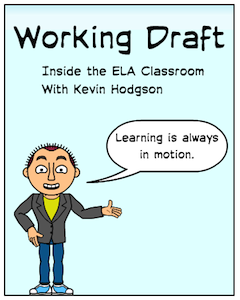Teacher as Writer: Taking a Poem for a Walk
A MiddleWeb Blog
 Teachers need to write. I know that sounds preachy, and I apologize, but I do believe it to be true. If we want and expect our students to be writers, then we teachers need to be writing, too, and we need to be sharing our paths to texts and purpose with them.
Teachers need to write. I know that sounds preachy, and I apologize, but I do believe it to be true. If we want and expect our students to be writers, then we teachers need to be writing, too, and we need to be sharing our paths to texts and purpose with them.
This month, I have been part of a loose network of teachers considering digital poetry, exploring the potential influence of technology and digital composition on the writing and publishing of verse. (You can join us with the #digipoetry hashtag on Twitter).
For this line of inquiry, it is not enough to ponder from afar what student writers might do with technology. You really need to dig in, write poetry with digital tools yourself, and then reflect on the experience.

In my head, I’ve been taking this poem for a walk. I also made a decision early on to document my writing as digital portfolio, using Storify as a way to gather up the poem in its many forms and to write reflectively about my role as a writer.
NOTE: You can view this Storify portfolio at full size here. Clicking on slides like VoiceThread, TitanPad & Notegraphy will open those apps. You can play video clips too.
The classroom impact
You may be wondering, what are the teaching implications for this kind of writing and exploration? There are many. First, there is the exploration of a range of digital tools, some of which I am already bringing into my classroom as my students work on poetry. We’ve done “shape poems” and will push into digital storytelling later.
Then, there is the reflective stance that the Storify collection represents – documentation of the writing process from start to finish and beyond – as a way to understand and evaluate what a writer has done. Finally, there is also the element of a writer writing, of making visible how a poem moves from raw ideas to “finished” product.
For many students who see a piece of writing and think “I could never do that,” this sharing can be an eye-opening and welcoming experience. The same can be said for the teacher’s experience, if they are honest about their process with students and bring in rough as well as polished writing samples.
Take some time to write today, and share your thinking process with those you teach.





























